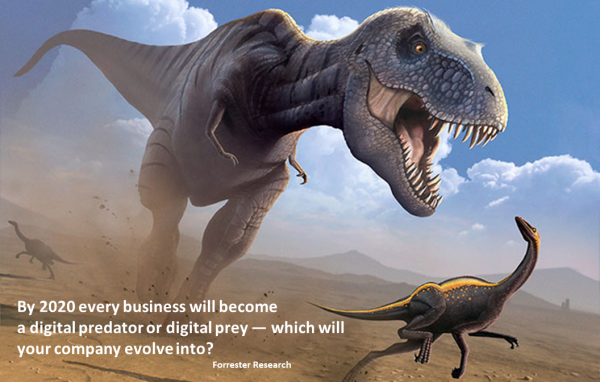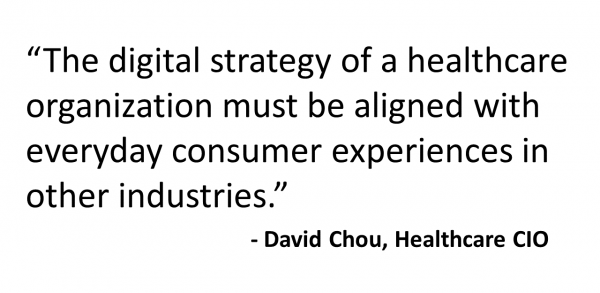 Healthcare CIO Series: Interviews with David Chou, CIO
Healthcare CIO Series: Interviews with David Chou, CIO
I am teaming up with CIO David Chou (@dchou1107), an executive with more than 13 years of experience in the healthcare industry to bring you a series of blog posts that provide a unique perspective on some of the healthcare industry’s biggest trends and challenges. David has been named to several “Top Social CIO” and “CIOs to Know” lists. He is a visionary and resourceful leader with expertise in healthcare and digital technology and a proven track record of delivering innovative, state-of-the-art solutions.
In our first post we took a look at the Evolving Role of the Healthcare CIO. In this interview we focus on digital transformation in healthcare and the impact the digital era is having on patient care and the overall mindset of healthcare organizations. We have invited Melody Smith Jones (@melsmithjones), Manager Connected Health, Perficient to join us and provide her insights into healthcare digital transformation.
According to Forrester Research, by 2020 every business will become a digital predator or digital prey. Healthcare organizations are not immune to digital transformation and it is imperative for the executive leadership team to identify where their organization is in terms of digital transformation and formulate a strategic plan to get where they need to be. It is critical for an organization’s digital strategy to align with consumer expectations.
KATE: How has digital impacted the healthcare industry and what can we learn from other industries in regards to digital transformation and the impact on consumer experience?
DAVID: Digital has changed our lives dramatically and the healthcare consumers expect the same experience that they currently receive from the other sectors such as retail, banking, and hospitality. Think about how the experience has changed dramatically in the airline industry. We have the ability to make flight reservations, select our seat, and create an online boarding pass all from a website, kiosk, or mobile app. Let’s now look at the entertainment industry, this experience has also changed. How do we watch movies and listen to music now compared to 5 years ago. Do you still buy DVDs and CDs or are you utilizing the services of Netflix, Amazon, Hulu, or Spotify. What about our experiences with hotel reservations? We can now make reservations, check-in and check-out, and also get our room keys all through a mobile app. Healthcare consumers are looking for the same convenience, transparency and experience that they are getting in these other industries. We need to create this same level of consumer experience in healthcare. Does your healthcare organization have a mobile app for scheduling an appointment or the ability to pay with a digital wallet (Apple Pay). The digital strategy of a healthcare organization must be aligned with everyday consumer experiences in other industries. Leading organization not only understand this but they are making strides in changing the traditional healthcare philosophy.
KATE: What excites you about how digital is transforming healthcare?
MELODY: I think this question is best answered in the context of what originally inspired me to work in healthcare technology in the first place. In 2003, my grandmother lived with and died from cancer in rural America. She lived an hour away from the closest hospital, and that geographic span had an incredibly noticeable impact on quality of care. Here I was, a marketing technologist by trade. I had already seen how digital technology was being used to make the brightest calculus teachers in the world, who had traditionally only been available to 30 students per hour, available to the entire world. Helping her through the dying process made me want to see innovations in how we are using the technologies that people interact with to change how care is delivered.
I am so pleased to see just how far we have come since 2003 in that regard! As healthcare organizations become increasingly more mature in terms of digital transformation, you will continue to see how the geographic boundaries around care will become increasingly diminished. For me, there is nothing more exciting than that!
KATE: How is bringing digital technologies and the adoption of those technologies to healthcare different than other industries?
DAVID: The challenge that I see in healthcare is that it is traditionally known as a risk adverse industry so there is a lot of hesitancy in adopting the latest technology. The cultural mindset is changing based on my discussions with various leaders in the industry. Healthcare leaders are making the digital shift now, but it is a lot slower compared to other industries. The second challenge is with IT. Most enterprise systems are built on legacy infrastructure and software development platforms. There are a lot of healthcare application systems built on Mumps and Cobol programming language that must be addressed. The biggest challenge for healthcare organizations is to redesign these enterprise systems without having to do a complete rewrite. The combination of culture and legacy system designs are the two largest barriers healthcare is trying to overcome.
KATE: What are the benefits of having a digital strategy?
MELODY: In healthcare, when we consider a digital strategy we often think of the marketing department. We think of tweets and websites and consider those to be the quaint things that the marketing department spends their time pursuing while the rest of the organization gets down to the real business or providing care and keeping populations healthy.
At the same time, we are looking at the way that digital technologies are being used in healthcare, and I am hearing things like, “Well, the patient portal is great, but we care most about the people that aren’t even using the patient portal yet. How do we connect with them and make sure they are staying healthy and following their care protocols?” When that question is asked, then we are at the root of what a digital strategy is meant to accomplish. What more mature healthcare organizations are realizing is that digital outreach to unknown consumers, the job of the marketing department, is a tremendously powerful platform for both population health and converting unknown consumers into patients. A strategy correctly isolates the strategic aims of the organization and then prescribes the people, process, and technology needed in order to effectuate those real tangible life-saving goals.
KATE: What technologies are imperative for digital transformation?
DAVID: When we talk about digital and living in the “digital” world it will encompass the four core technologies of social, mobile, analytics and cloud (SMAC). It is imperative that healthcare starts adopting these technologies. I have seen too many risk adverse healthcare organizations fighting the digital trend. Social should be a place for collaboration, engagement and customer service. We should not be afraid to use this communication channel. Healthcare organizations are too focused on privacy and security so they are missing out on the benefits of social technology. The same goes for cloud. Traditional healthcare IT still wants to manage infrastructure and many security officers and compliance officers argue that their data is safer on premise where they can physically touch the servers. That mentality does not work in the digital age we are in and the organizations that continue with this mindset will be lagging behind others.
KATE: There have been new technologies such as Google Glass and Apple Watch that have not lived up to their hype – does this impact your willingness to look into new technologies?
DAVID: Definitely not. I would not classify Google Glass and Apple Watch as failures yet in healthcare. Healthcare is trying to put together the right use cases for these technologies. In my opinion the entire healthcare provider industry has been focusing on enterprise EMR implementation and ICD10 and they have not had the time to focus on innovation and digital strategy. Consumer technology such as wearables and sensors will be part of healthcare delivery and we must figure out how to integrate the data into the enterprise. The future of big data in healthcare will be filtering and I see a lot of potential new technologies in the pipeline that will benefit patient care.
KATE: Healthcare organizations can collect information from various patient touch points but how can that information be used?
MELODY: I often discuss data sources when in conversations about “retail strategy” for healthcare. In retail, say your local grocery store, data about your personal spending habits is used to predict your future behavior as well as to motivate and incentivize your future interactions. This data is collected, typically, by way of membership in loyalty programs. As part of my graduate research, I worked with a nationally recognized grocer to mine data and strategize around interactions in the shampoo category, which is an anchor in beauty care. It’s fascinating work that has a monumental impact on the bottom line, but how does that relate to healthcare?
First, retail organizations would be absolutely jealous of the amount of data that healthcare organizations have at their disposal. True, we are limited in what data sets can be used in marketing programs, but our true goal in using data cross patient touch points is largely in balancing the cost/revenue equation. That’s what retail strategy is all about. Even more, if I had to pick a core competency that healthcare has that is not found in other industries, then it would be the industry’s ability to utilize data for the purposes of research, diagnosis, efficiency, etc. In other words, we have the data, we have the competencies with data, we are just not always viewing that data through the “retail strategy” of gaining insights that motivate and incentivize population behavior.
This is the second in a series of blog posts featuring Healthcare CIO David Chou. Look for additional interviews where we take a look at some of trends and challenges in the healthcare industry.
Follow me @kateDTuttle


